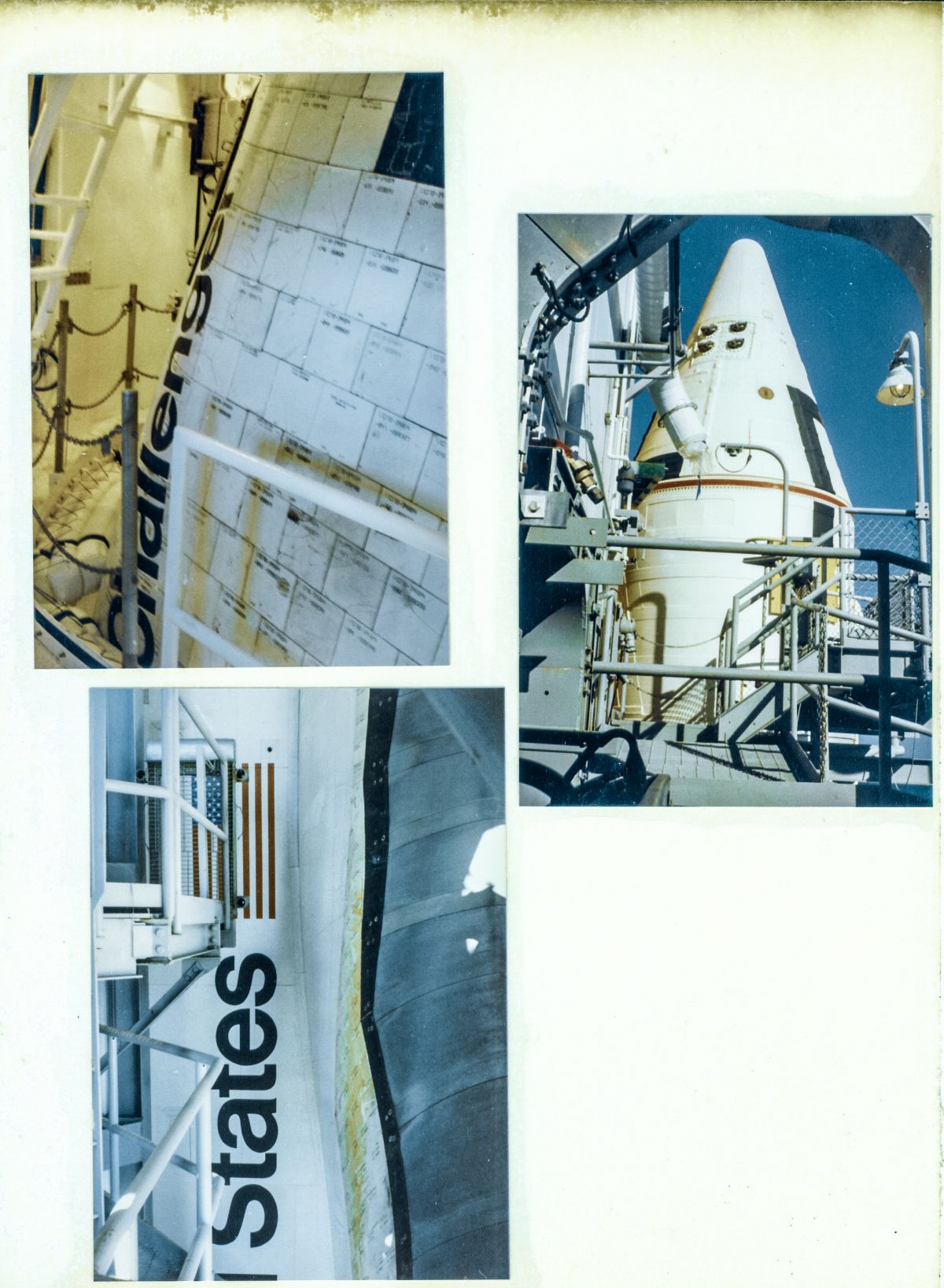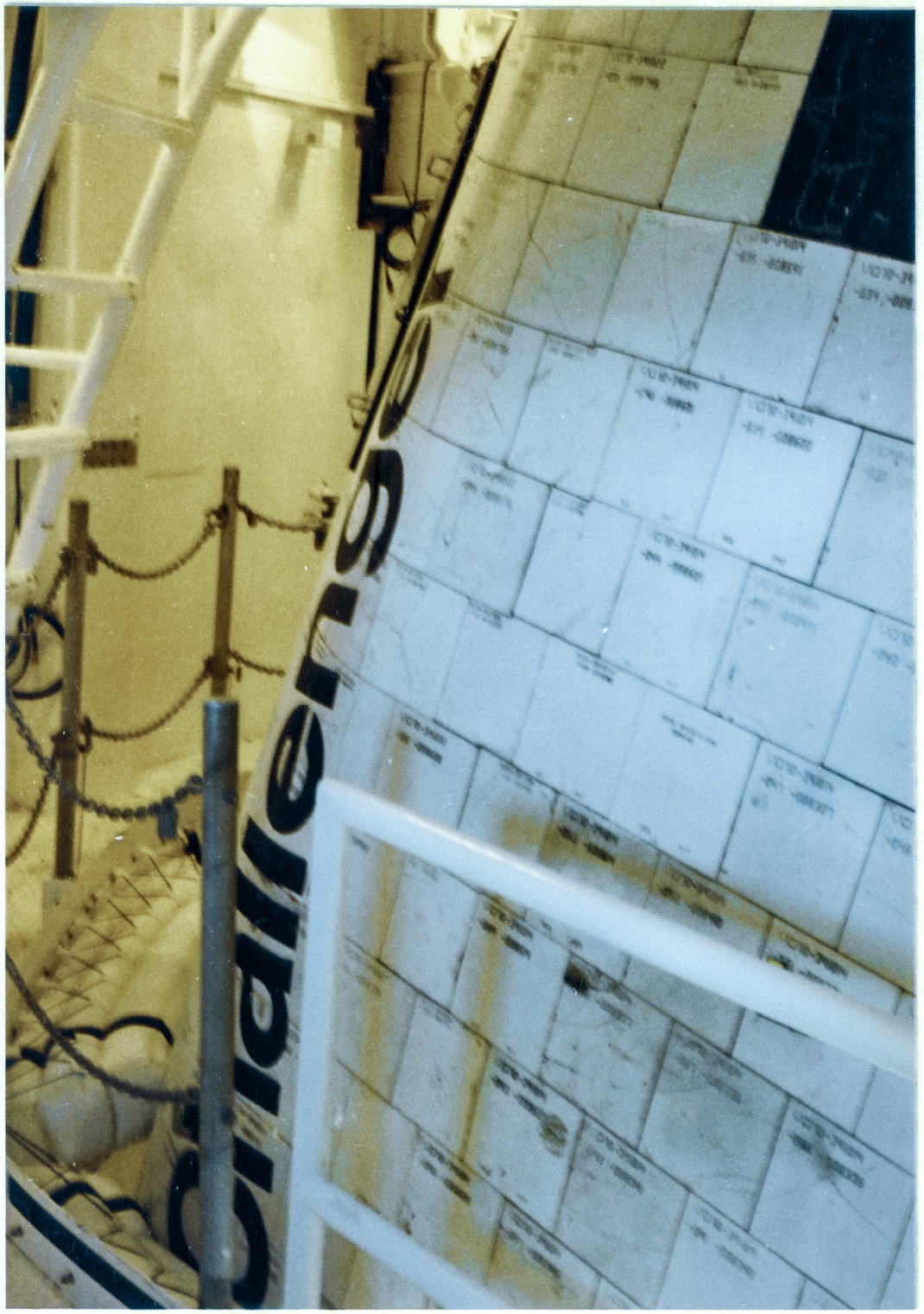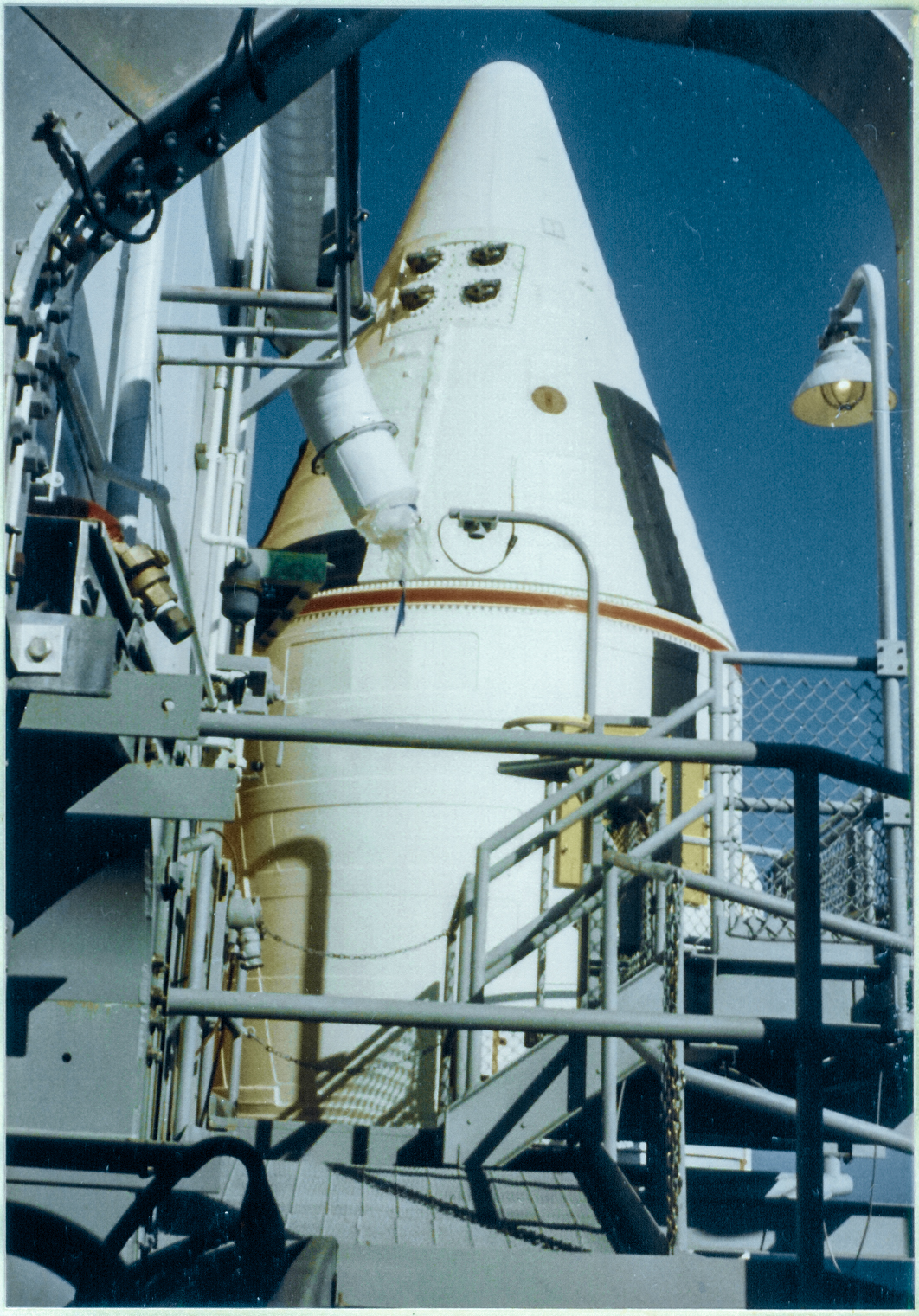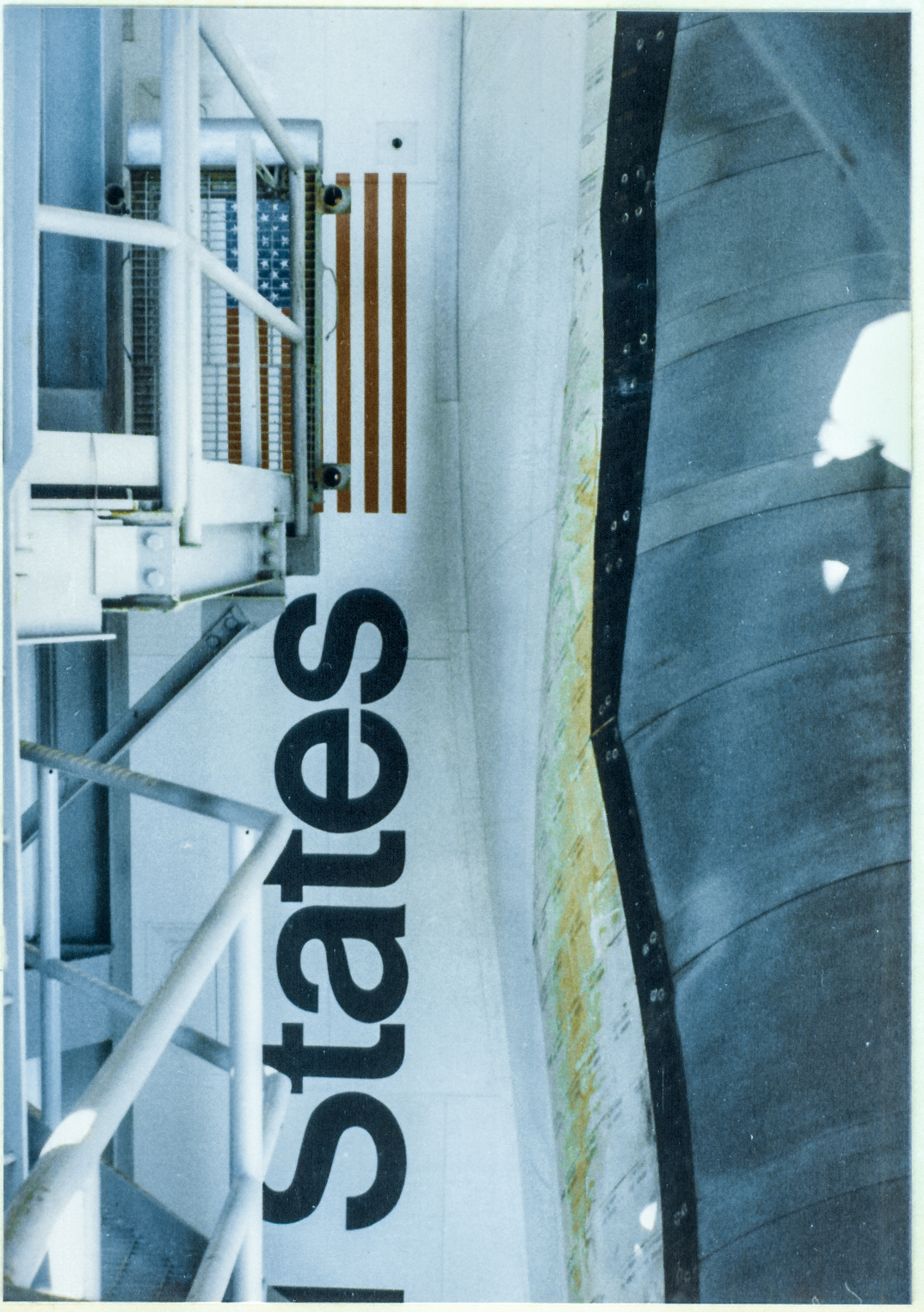Space Shuttle Launch Complex 39-B Construction Photos
Page 25
Challenger on B Pad - Page 1
(Original Scan)
Bittersweet.
These shots were taken in the week between Christmas and New Year's, very late 1985.
This was going to be the very first Shuttle launch off of our brand-new tower.
All work had more or less come to a stop for the holidays, and it was cold this week. Florida has cold winters and warm winters, and the winter of '85/'86 was a cold one. There were large masses of ice on the tower, here and there, and up in the air, exposed to the strong northwest wind, you could really feel the cold cut right into you. They say Florida is warm, but that's not always the case, and an examination of record low temperatures during December, January, and February will show that every once in a while it gets pretty cold.
I had the entire tower to myself. Not a single other soul around. The whole place, save a few guards down at the gate, was deserted. Lonesome. Wind moaning through the steel structure. All alone.
Top left is from just beneath the RCS room, looking at the right side of the orbiter, right where the body first begins to taper down to the nose.
Top right is from the decking between the Hoist Equipment Room and the RCS room, looking north toward the top of the right SRB, which is the one that failed.
Bottom left is from one of the intermediate-level platforms on the right side of the RSS, looking at the root of the right wing of the orbiter.
Additional commentary below the image.

Background Info:
I've been dreading this page coming, from the very beginning when I first decided to do this, but now it's upon me and I'm just going to have to face it.
By this time, the main contract for finishing off the structural elements on the pad was done, and Ivey Steel had me over on Pad 41, working the tear-out and refurb of the MST and UT, as part of the modifications required to ready that pad for Titan IV, which was the "Complimentary Expendable Launch Vehicle" that the military belatedly realized would be required, to avoid putting every last one of their eggs into a single basket labeled "Space Shuttle" should, god forbid, that basket and all the eggs contained within it, somehow break, thus depriving the United States of any ability to place heavyweight-class national assets into orbit around the planet.
But work continued on B Pad, and part of that work consisted in what may as well be called an Engineering punch list, finishing off a multitude of little nicky-picky stuff that had fallen through the cracks previously, but every bit of which needed to get dealt with in order to render Pad B into operational, flight-ready, status.
There was a separate contract for this stuff, but I do not recall its name, and the contract was written so that each separate element, each separate work order, each separate little thing that was discovered along the way and needed to be rectified, was handled separately as a distinct work package that we would receive, come up with a cost and schedule for, and submit to NASA for approval, and then, once approval had been given, we would buy the materials, furnish the labor, install and/or modify the item in question, inspect the work, submit the completed work to NASA, who would then inspect it for themselves, sign-off on it, and only then would they pay us for what we had done.
Just the usual blizzard of incoming paper that would then be converted into a readying of tools, equipment, material, and manpower, all of which would be mobilized to the work area, afterwhich the work would be done and bought-off and a bill would be sent to NASA.
Or at least that's what it looked like on paper.
In actuality, just as soon as we received a work order, we went to work on it immediately, and the paper could, and did, follow the work, and sometimes by a significant amount of time.
NASA needed it done this way because time was running out, and there was going to be a Space Shuttle (which was on its own schedule) on this pad very soon, and nobody had any time for all the bullshit required for formal adherence to the FAR, which was winked at, as we blew right on by it with torches, and welding leads, and checkerplate, and touch-up paint, and whatever else it was that we needed to get it done. Now.
Make no mistake, had we tried anything, had we attempted any skulduggery, that shit would have been caught at some point down the road, and measures would have been taken, but that never happened. We enjoyed our regard as straight-shooters with NASA, and we played it straight, by the rules, with every one of these little work orders, and and we got the sonofabitch done on time and within budget. Honestly. The way you're supposed to do it.
They really hated "time and material" contracts, and they had very good reason to do so, but by this time Ivey had demonstrated sufficient competency and honesty to permit them to be one of the select few that were permitted to bid on this thing, and we won the bid, and whatever things might have actually been called, what it was, was a "time and material" contract, and we were the ones who were doing it, and I got taken off of the work at Pad 41 and was brought back over to B Pad once again, for what were to be my final days there, five long years after first showing up as a green recruit who's sole purpose in life was to keep a chair warm and answer the telephone when the boss wasn't around to answer it himself.
We were the approved contractor, and that spoke better than anything else could, towards our own competency and trustworthiness, and to this day I consider that high praise indeed, for the work we did.
All kinds of stuff got covered, and I was, among other things, the guy who wielded Ivey's QC stamp during this phase of things, and as each separate little work activity was completed, I held the responsibility for inspecting that work, verifying that it was done correctly per the plans and specifications, whereupon I would take my little round QC stamp, stamp the relevant paper, and submit it to NASA, officially giving them notice that what was done, was done properly, and that it was time for them to come and give things a look, for final approval, so that additional work could be taken up elsewhere.
It was time to get the hell off the pad and let the operations people on, so they could get down to work flying Space Shuttles from something that was no longer a construction site, but instead was now a proper operational launch facility.
My very last days on Pad B.
Top Left:
(Full-size)

So on one very cold day (Ask anybody from up north who's felt it, how a day with a roaring northwest wind and a temperature in the 20's [Fahrenheit, please] in Florida feels like, ok? They all seem to agree that it's a completely different sensation from what a temperature in the 20's feels like "back home" and although I really do not understand the mechanisms of such a thing, I do understand the reality of it, and for me, that's enough.) during the week between Christmas and New Year's Day in the waning days of 1985, when everything was pretty much shut down and I found myself with some free time, I drove out to B Pad, presented my badge to the guards, and then went on up the completely-deserted tower. There was no one around, and the wind moaned and whistled through the structure, draped with ice in surprisingly-large patches here and there, as I tramped my way around on it, completely alone. I wish I could describe the feeling of walking around on that tower being careful not to slip on some of the large areas of ice which covered the steel bar grating, in the freezing hard-sunlit gale, with that gigantic spaceship sitting on it, mated to the RSS, but I cannot. It was very haunting, very lonesome, very isolated, very... boy, I do not know. I do not know how to express it. I am sorry. I cannot help you with this. These are among the most powerful and telling memories of my life, and as with all such things, they are impossible to sensibly convey to someone else.
They had already rolled a launch vehicle out to the pad, for the very first time, and through the cut of the northwest wind, I walked around on the RSS and took a few pictures of that first-ever vehicle to be rolled out to our brand-spanking-new launch pad.
And that launch vehicle's name was "Challenger."
There is a narrow checker-plate access platform/catwalk that runs along the front of the RSS just beneath the overhang of the RCS Room. My first-ever step on to a frighteningly-mobile wooden ladder which was tied to the structure with some rope and nothing else, down on to an even more-frighteningly mobile wooden float which was tied to the structure in the exact same way, occurred on this very steel, this exact steel, and I remember it with tack-sharp clarity, all these long years later.
There's also a rolling aluminum ladder located here, hung from a small trolley that rides along on the bottom flange of a curved monorail beam attached to the underside of the RCS Room floor framing steel, and we had trouble with the curve as-specified for that monorail beam when we originally fabricated it, and I remember that well, too. This aluminum ladder (which you can see a bit of in the top left corner of this image) has a set of wheels on its bottom and they roll along the checker plate of this steel ledge and the ladder gives technicians access to the (very awkwardly located, coming at them from the outside when the bird is on the pad) front windows of the Space Shuttle crew cabin. And that aluminum ladder was difficult to fabricate, too, in case you were wondering.
You take a stair down on the Column Line 7 side of the area next to the RCS Room to get to a door (arrow with heavier border) you open up and walk through to get to this platform/catwalk (It's really neither one nor the other, and I can't decide which incorrect term to use, so I'm just going to use them both, ok?). And from here, you're just about even with that place on the side of the orbiter where the full width of its body just begins to narrow down toward the rounded tip of its nose.
You are standing on the platform directly adjacent to the right side of the crew cabin, and there will be people, right there, on the other side of those white tiles you see in this picture, when the Space Shuttle is on orbit, having been hammered there in under ten minutes by truly god-awful and fearsome forces, to a velocity of over ten times the speed of a rifle bullet, doing what it was designed and built to do.
Without the orbiter sitting there, that catwalk is a dangerous sonofabitch, and there's a couple of places as you walk along its length where it narrows down uncomfortably, and there's a smooth vertical wall of solid steel on one side, so you cannot kind of edge over a little bit away from the fifty-meter free drop to cold concrete that's closing in on you from the other side, protected only by a set of "safety" chains which give alarmingly with far too much slack when you brush against them, and dammit I just never did like this place. It's not a friendly place, ok? We'll leave it at that.
But when the orbiter's there, then all of a sudden it becomes quite benign, although I wouldn't recommend blundering into the orbiter's heat-shield tiles with your full weight, 'cause even though your fall would be blocked and you wouldn't take that life-ending drop all the way down to the pad deck, you would fuck up those ever-so-delicate tiles, and that would not go over very well with anybody at all.
Also, when the orbiter's there, blocking the light of day, what was previously a brightly-lit area with plenty of open sky to illuminate things suddenly becomes dark, and it requires artificial illumination, which you can clearly see by the color and look of the lighting in this image. What appears to be yellow "stains" along the side of the orbiter is in fact shadowing, created by the handrail you see, which is blocking the much-whiter light of day that's still coming in from outside, behind me, over my shoulder through the open doorway, leaving only the much-yellower light of the artificial illumination, coloring things in its absence.
Zoom on in, in the area of the bottom right corner of this image, and you can see that some of the tiles are cracked. This sort of cosmetic cracking was something they were well aware of and had determined would pose no threat, so they just went ahead and flew that way. Payloads are gleaming things that look like they were created for a science fiction movie, but the rocket ships that take them into space have a much rougher look to them on their exteriors, and this surprises some people.
Look closely in the area around the very bottom of the handrail posts, and you can see that the inflatable seals that surround the orbiter in this area are inflated, and are in contact with the vehicle.
Consider for a moment that the area with the handrail posts sticking up is solid steel. Notice how close it is to the fragile tile skin of the Space Shuttle. Which can never be touched by hard steel.
Now consider the fact that that steel is just one tiny part of an impossibly gigantic and complicated structure that's easily as big and heavy as a large hotel, and that hotel has managed to pivot around horizontally from a great distance, through one-hundred twenty degrees of rotation, like a goddamned door being closed, well over a hundred feet away, and yet stop that close and no closer.
Some of what goes on out at the Cape just beggars the imagination, and this innocent-looking image can provide a clue about that kind of stuff for those with the eyes to see it.
And so, on a very cold day in Florida during the last week of 1985, I came to this platform and I took this picture.
Top Right:
(Full-size)

You are standing on top of the RSS in the area between the RCS Room and the Hoist Equipment Room, looking directly north past the Column Line 7 side of the RCS Room, at the top of Challenger's right SRB. This is the SRB that failed when they flew the very first Space Shuttle mission from Launch Complex 39-B.
Bottom Left:
(Full-size)

This image is taken from an unusual location, and at first I presumed it was from somewhere near the OMBUU, but then I realized that the OMBUU is over on the left side of the orbiter, and this image is very clearly looking at the orbiter's right side.
So ok, so where are we?
I did a little digging, and went to the image of Pad A (First rollout of the Space Shuttle Discovery), which serves as the blurred and softened background image for the table of contents to these photo essays, to get a better look at things, and although the configuration is not exactly the same as it is on B Pad (ongoing mods to the OWP System, I'd imagine, but I really can not know why the subtle differences that are there have been implemented), I found the place where I was standing when I took this photograph (tip of arrow is camera lens location and horizontal bar below that is where my feet were located, upon the lower of the two platforms) so as you can understand precisely where this image was taken from, and what you'd see if you were standing there yourself with the RSS in the mated position with an orbiter on the pad, but fallible memory has left me no traces of the names or the purposes of this pair of small platforms, which I was standing on, leaning out over the handrail to get a better angle for taking the picture.
So that's where we are, then. Over on the far side of the RSS from the FSS, maybe a little more than a third of the way up from the SSME's down at the very bottom of the orbiter, looking at the area of the wing root on the right wing, just aft of where the gray carbon-carbon panels start to show up on the leading edge of the wing.
I had no idea what I was really looking at this day.
None at all.
Return to 16streets.comACRONYMS LOOK-UP PAGEMaybe try to email me? |